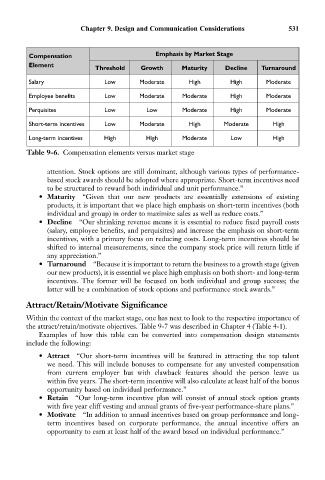Page 545 - Bruce Ellig - The Complete Guide to Executive Compensation (2007)
P. 545
Chapter 9. Design and Communication Considerations 531
Compensation Emphasis by Market Stage
Element
Threshold Growth Maturity Decline Turnaround
Salary Low Moderate High High Moderate
Employee benefits Low Moderate Moderate High Moderate
Perquisites Low Low Moderate High Moderate
Short-term incentives Low Moderate High Moderate High
Long-term incentives High High Moderate Low High
Table 9-6. Compensation elements versus market stage
attention. Stock options are still dominant, although various types of performance-
based stock awards should be adopted where appropriate. Short-term incentives need
to be structured to reward both individual and unit performance.”
• Maturity “Given that our new products are essentially extensions of existing
products, it is important that we place high emphasis on short-term incentives (both
individual and group) in order to maximize sales as well as reduce costs.”
• Decline “Our shrinking revenue means it is essential to reduce fixed payroll costs
(salary, employee benefits, and perquisites) and increase the emphasis on short-term
incentives, with a primary focus on reducing costs. Long-term incentives should be
shifted to internal measurements, since the company stock price will return little if
any appreciation.”
• Turnaround “Because it is important to return the business to a growth stage (given
our new products), it is essential we place high emphasis on both short- and long-term
incentives. The former will be focused on both individual and group success; the
latter will be a combination of stock options and performance stock awards.”
Attract/Retain/Motivate Significance
Within the context of the market stage, one has next to look to the respective importance of
the attract/retain/motivate objectives. Table 9-7 was described in Chapter 4 (Table 4-1).
Examples of how this table can be converted into compensation design statements
include the following:
• Attract “Our short-term incentives will be featured in attracting the top talent
we need. This will include bonuses to compensate for any unvested compensation
from current employer but with clawback features should the person leave us
within five years. The short-term incentive will also calculate at least half of the bonus
opportunity based on individual performance.”
• Retain “Our long-term incentive plan will consist of annual stock option grants
with five year cliff vesting and annual grants of five-year performance-share plans.”
• Motivate “In addition to annual incentives based on group performance and long-
term incentives based on corporate performance, the annual incentive offers an
opportunity to earn at least half of the award based on individual performance.”

